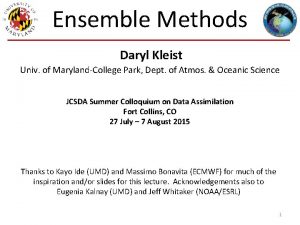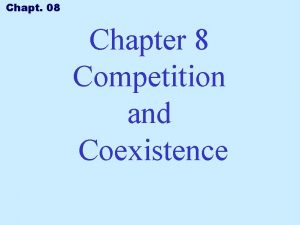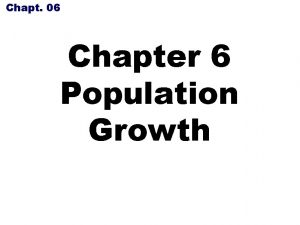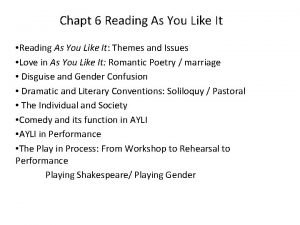Chapt 10 Reading Kleist and Hoffmann p 247














- Slides: 14

Chapt 10 Reading Kleist and Hoffmann (p: 247 -65 RW) • Kleist’s The Betrothal in Santo Domingo • Hoffman’s The Sandmann • These are two short stories, that is prose rather than poetry, written by two German Romantic writers. • This chapter deals with Romantic writing outside England, to show that Romanticism was spreading throughout Europe.

Chapt 10 Reading Kleist The Betrothal in Santo Domingo (p: 247 -56 RW) • In Die Verlobung in Santo Domingo ("Betrothal in St. Domingo", 1811) Kleist examines themes of ethics, loyalty, and love in the context of the colonial rebellion in Haiti of 1803, driving the story with the expected forbidden love affair between a young white man and a black rebel woman, though the reader's expectations are confounded in typically Kleistian fashion, since the man is not really French and the woman is not really black.

Chapt 10 Reading Kleist The Betrothal in Santo Domingo (p: 247 -56 RW) • Here for the first time in German literature Kleist addresses the politics of a race-based colonial order and shows, through a careful exploration of a kind of politics of color (black, white, and intermediate shades), the self-deception and ultimate impossibility of existence in a world of absolutes.

Chapt 10 Reading Kleist The Betrothal in Santo Domingo (p: 247 -56 RW) • The story describes the situation in Haiti during the revolution. The former black slaves were on a campaign to exterminate the all white people. The group described in this story was Congo Hoanga, who was an extremely violent warlord who killed his master and took over his plantation. Not only does he go on excursions to slaughter fellow humans, he also uses the old woman and Toni to deceive whites who come to the door while he is away.

Chapt 10 Reading Kleist The Betrothal in Santo Domingo (p: 247 -56 RW) • Toni is to use her beauty to keep them there until they can be ambushed. The campaign describes the systematic slaughter of a helpless race of people. Their power had come from money, but once the revolt began, money could not save them.

Chapt 10 Reading Kleist The Betrothal in Santo Domingo (p: 247 -56 RW) • The other interesting part is the similarity to Shakespeare, specifically Romeo and Juliet. In Kleist’s story, Toni and Gustav, from two different “families” fell in love. But because of the current situation, they could not be together and Gustav was in fatal danger. In her attempt to save Gustav, she had to tie him up, thus appearing to betray him. When Gustav’s family came to rescue him, he shot her with his pistol to prevent her from betraying him again. When he discovered his error and her love, he shot himself

Chapt 10 Reading Kleist The Betrothal in Santo Domingo (p: 247 -56 RW) • One strong motif used in Kleist’s “The Bethrothal of Santo Domingo” is color. In particular white, black and yellow. At first glance the obvious connection you make is that white represents good and black represents the bad and for about ninety percent of the story that is true. But Kleist really makes his statement in the end. He blurs the lines of color completely out of focus.

Chapt 10 Reading Kleist The Betrothal in Santo Domingo (p: 247 -56 RW) • The story takes place on a limited scale within a larger conflict between black and white. Essentially as the story unfolds it becomes apparent that the line between the good and the bad is also the line between the black and white characters in the story. Representing the good are people like Gustav, Her Stromli and Stromli’s party.

Chapt 10 Reading Kleist The Betrothal in Santo Domingo (p: 247 -56 RW) • On the side of the bad lies Babekan, Congo Hoango and his followers. However where the issue become more complex is in the person of Toni is described as yellow (Métis) in a blatant attempt to distance herself from the rest of the “black” people. Yellow is used as a way to put her sort of in between the two groups which is perfectly accurate for the majority of the story. During the course of events of the story Toni kind of goes back and forth between sides mentally.

Chapt 10 Reading Kleist The Betrothal in Santo Domingo (p: 247 -56 RW) • The story makes its point at the very end. The heart of the message within the story is at the end. It bears some resemblance to “Romeo and Juliet”. In the end Gustav blindly kills Toni who is really his savior and hero. Kleist delivers a message that color or creed is not so important as a persons ability to reason. Kleist’s writing often has a theme relating to reason. The moment when Gustav stopped thinking with his head and just reacted unthinking is the moment he lost his love.

Chapt 10 Reading Kleist The Betrothal in Santo Domingo (p: 247 -56 RW) • In the end it was not Toni’s color that mattered it was the power of her mind and her heart that ended up keeping everybody safe. The real moral of the story is that reason above all else should govern your decisions because if you act on prejudice or emotion your judgment lies in question.

Chapt 10 Reading Kleist The Betrothal in Santo Domingo (p: 247 -56 RW) • Historical context of Kleist’s story: • It was written in 1807, Slavery was abolished in 1809. • Fr rev ended with massive massacres and guillotining. • Black revolutionary leader Toussaint L’Ouverture died in 1803. He had a desire to free Haiti, but he died and Dessalines achieved the task in 1804. • Quote P: 248. Those who taste liberty, would never allow themselves to go into servitude again. • Race war started with the drowning of over 1000 blacks in Le Cap Harbour

Chapt 10 Reading Kleist The Betrothal in Santo Domingo (p: 247 -56 RW) • Kleist's philosophy is the ironic rebuff of all theories of human perfection, whether this perfection is projected in a golden age at the beginning, in the present, or in the future. His works show man torn apart by conflicting forces and held together on the surface only by illusions, like that of real love

Chapt 10 Reading Kleist The Betrothal in Santo Domingo (p: 247 -56 RW) • Kleist and Hoffmann’s biographies → instability • Kleist and his ‘lebensplan’ and the swings of his own allegiances. He wanted to join the Napoleonic army, but was refused. He turned nationalistic. • Hoffmann lost his civil service job, when Napoleon conquered Germany → switched his career to music, became a composer. • Socio-economic changes brought about some sort of alienation, as depicted in The Sandmann (p: 254 -6)
 Pre reading while reading and post reading activities
Pre reading while reading and post reading activities Dr kleist neurolog
Dr kleist neurolog Daryl kleist
Daryl kleist Daryl kleist
Daryl kleist Kleist health education center
Kleist health education center Kleist health education center
Kleist health education center Daryl kleist
Daryl kleist Daryl kleist
Daryl kleist Daryl kleist
Daryl kleist Ngget
Ngget Patienten pro pflegekraft europa
Patienten pro pflegekraft europa Guilherme hoffmann desempregado
Guilherme hoffmann desempregado Biomas de chile mapa
Biomas de chile mapa Prof. dr. volker hoffmann
Prof. dr. volker hoffmann Algoritmo distribuido
Algoritmo distribuido



























